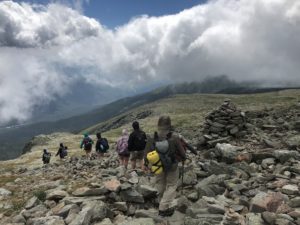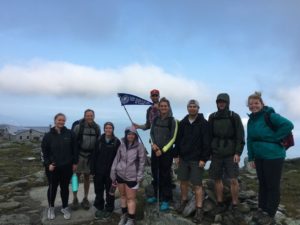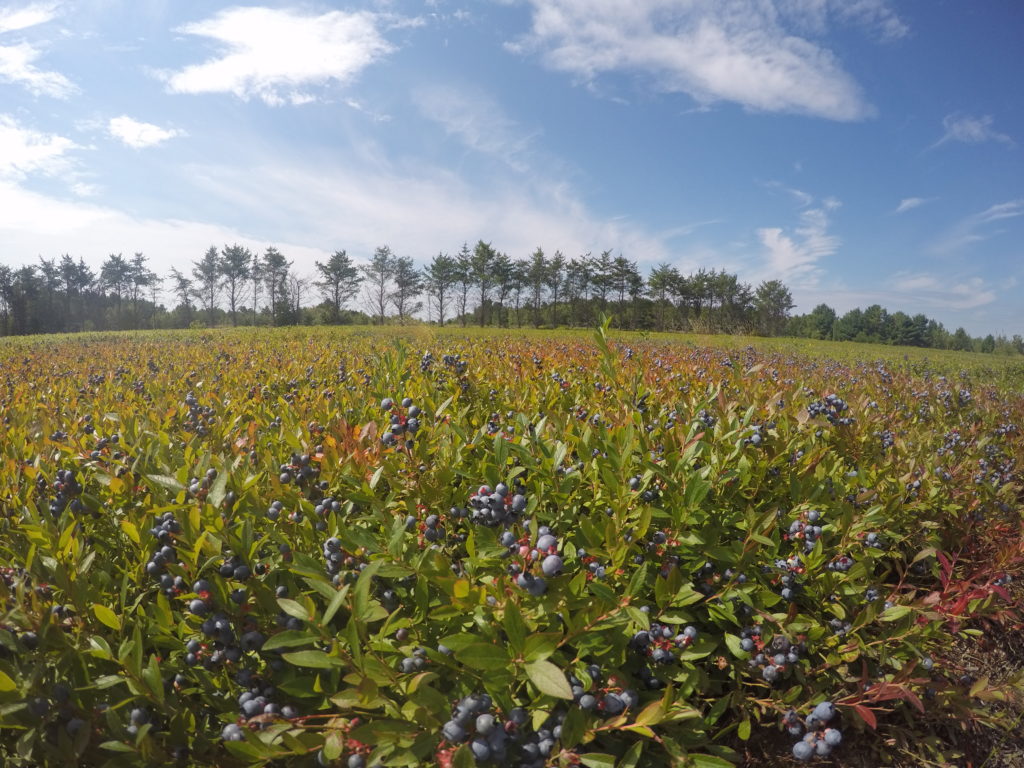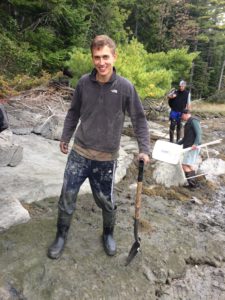

— Kaitlynn Hutchins



— Kaitlynn Hutchins


This past week allowed many of us to step out of our comfort zone and test our limits in the White Mountains of New Hampshire. Mount Washington is the highest peak in northeastern North America and known as the “Home of the World’s Worse Weather.” After riding in a van to the summit, we were given the opportunity to descend from the Alpine Garden to Lakes of the Clouds. Standing right on the ridge, we witnessed the “orographic effect” first hand. It occurs when cold air rises over the top of the ridge, forming a cloud. Then, as the air descends the other side of the ridge, the air warms and the cloud vaporizes. Although it was foggy, the experience was still exhilarating!

We spent the night at the Appalachian Mountain Club (AMC) Lakes of the Clouds Hut. We continued our journey down Tuckerman’s Ravine bright and early the next morning. About half way down, we stopped for a “yellow notebook moment” where we applied what we previously learned to our observations.

Tuckerman’s Ravine is a glacial cirque. This means the glacier carved out the side of the mountain. Imagine a scoop carving out a giant mound of ice cream, slowly, over thousands of years. In this moment it was amazing to see that all of our hard work really paid off. Although it was a long, intense journey down, the views of the cirque and alpine environment were absolutely gorgeous. It was something many of us have never been given the chance to experience. So far, this opportunity has allowed us to explore the world from a much different perspective!

As the first week comes to an end, we’re off to our next stop: Wells National Estuarine Research Reserve in Wells, Maine.
-Becca Regan

 On Sunday, August 12th, we met in Portland to depart on our ten week trip to learn new content, explore new places, and experience new things. We headed for the AMC Highland Center at Crawford Notch, part of the White Mountain National Forest in New Hampshire. We stopped along the Saco River along the way to learn about grain size, the energy of the current, and river depth. When we got to the Highland Center it was cloudy but the views were still amazing!
On Sunday, August 12th, we met in Portland to depart on our ten week trip to learn new content, explore new places, and experience new things. We headed for the AMC Highland Center at Crawford Notch, part of the White Mountain National Forest in New Hampshire. We stopped along the Saco River along the way to learn about grain size, the energy of the current, and river depth. When we got to the Highland Center it was cloudy but the views were still amazing!
The first class being covered is Glacial Geology and Climate Change. We’ve been learning about glacier formation, movement, and erosion features. To see real life examples of the concepts, we hiked Mount Willard on our third day. Mount Willard overlooks Route 302 and Crawford Notch with 4,000 foot mountains on either side, a textbook example of a U-shaped valley created by a glacier that carved its way through during the Pleistocene glaciation.
When we aren’t in the field learning, we are in class learning about what we will be seeing in the field. For the last four days, class time has been broken up throughout the day by intense games of cornhole, cribbage, spoons, ping pong, quick hikes, food breaks, and wildlife sightings. On the fourth day of our stay, Dr. Erikson informed us of a bear cub and mom that he had just seen near the Mount Washington Resort. We quickly piled into the van and, sure enough, came upon a crowd of people taking pictures. A first bear sighting for most of us! After watching for a while, we drove back toward the Highland Center and came up on more cars pulled over. Another bear? No, this time a moose! Another first for some of us. Thanks to Jarrett’s moose call we were able to get a good picture with the young bull. What a great first four days with a great group of people!
Stay tuned for more!
-Caleb Gravel
It’s time for me to write a post, since the students are immersed in writing a paper and preparing for a final in Climate Change and Glacial Geology. Yes, it is very early September and they are faced with a paper and a final. We’ve been on the road for over 3.5 weeks, which puts us 1/3rd of the way through the ESS. Quite soon, we will finish here (Crawford Notch in the White Mountains of New Hampshire) and head to Popham Beach, where Prof. Greg Teegarden will start leading the students though Marine Ecology. But before we wrap up here, let me point out some highlights.
Blueberry fields near Cherryfield, Maine grow on deltas that accumulated in a frigid sea when relative sea level was briefly 60 m higher than today about 15,000 years ago as glaciers receded. Joe O’Reilly joined me and Andrew atop an enormous boulder carried to this site by icebergs.

West Quoddy Head lighthouse is the easternmost point in the US. Everyone seemed amused thinking that there were 320 million Americans to the west of us, and zero to the east!
It’s hard to appreciate just how fast the tide can come in. At Fundy National Park in New Brunswick, we studied the 1 km long Point Wolfe inlet. We were in the flat, middle part of the section when the tide caught up with us. The water was creeping over the land nearly at walking speed. Stand still to take a measurement, and the water would rise above our ankles. Crossing the “little” intertidal stream on the incoming tide got Emma Mills ’19 in water up to her chest.
At Joggins Fossil Cliffs in Nova Scotia (a UNESCO World Heritage Site), we walked along beach cliffs (at low tide!) for about 5 km and through about 5 million years of ancient, really ancient history. These rocks have yielded the oldest reptile fossil in the world at about 310 million years (forgive me if my memory is off by a few million). We were there to look at how climatic and environmental conditions can be reconstructed; these rocks accumulated in a tropical swamp with nearby mountains generating a rich supply of river sediment. Danielle Martin ’19 found a block with fossilized mud cracks and the toe/claw imprints of a crocodile-sized amphibian; this block was so special the guides added it to the permanent collection in the site’s museum.
In Halifax, the city’s signature historical feature, the Citadel, is built atop a drumlin. The drumlin was formed by glacial ice moving and molding sand and gravel debris into an oval mound. Several of us enjoyed a nice hour of Frisbee tossing on this late Ice Age feature.
The moonless night sky in the northwoods east of Greenville was absolutely beautiful. Sorry, no nighttime photos, but I’ll include a morning photo. And nighttime photos wouldn’t do it justice anyways. The sky (as viewed from boats on the still lake) had so many stars that it felt four-dimensional – I felt the immensity of it as we looked deeper into space to more distant and fainter stars. Some students saw the Milky Way for the first time in their lives. Defintely a highlight.
Prof. Emily Lesher led us through an investigation of the chemistry and landscape associated with acid mine drainage. Strictly speaking, this material was part of the Field Methods course, but by now the students are used to switching back and forth between different course content. Personally, I really enjoyed seeing students engage with new material and another professor. Many of them will be in Prof. Lesher’s Environmental Chemistry class in the spring, when this real-world example will surely come up.
We drove up Mount Washington yesterday in order to get a view of several cirques created by alpine glaciers, most notably Tuckerman’s Ravine, Huntington’s Ravine, and the Great Gulf. A short walk to the lip of Huntington’s headwall led to more than one reassessment of what “steep” looks like. While there in the Alpine Garden, we enjoyed a late summer snack of wild blueberries and mountain cranberries. Some of us, including Jess Selva ’17 and Tyler Allen ’18, hiked over 4000 vertical feet from Mount Washington’s summit down over the headwall of Tuckerman’s Ravine and out to Pinkham Notch; legs were a bit stiff today!
We’ve endured just over 2000 miles of driving so far. It’s a really long way from Portland to Halifax. Fortunately, the longest distance to be covered in the remaining 6 weeks will be done on a schooner!
– Prof. Johan Erikson
For the past 3 days, we have been at the Appalachian Mountain Club’s Gorman Chairback Lodge in Greenville, ME. After a long drive from Halifax finishing with dirt roads, we finally arrived at this cute little lodge. After moving our things into our bunkhouse, we were allowed some down time until dinner. Gorman Chairback is right on Long Pond and it’s about a mile and a half from one end to the other. In no time at all we were out on kayaks, canoes, and paddleboards. It was a beautiful, calm day and the water was just the right temperature as we explored the full length of the lake.
Dr. Emily Lesher and her family joined us for a few days to teach us about the nearby Katahdin Iron Works and the iron oxide deposits that fed it. First we visited the original smelting furnace and the one remaining charcoal kiln that have been there since the 1890’s. Prof. Lesher told us about how pig iron was made from limestone, charcoal, and ore. As the workers removed the surface layer of iron oxide ore from the nearby surface deposits, fresh iron sulfide was exposed. From more than a century of exposure to rain and air, the acidic runoff is getting into nearby streams and rivers at lower elevations and iron oxide is coating the soil. We took soil samples from different kill zones, tested pH levels, and tested acidity levels to see how the acidic drainage was affecting the waterways. Since this past season has been so dry though, the water levels have decreased and the amount of runoff into the waterways has also decreased, leaving the pH levels high (nearly neutral) and the acidity levels low.
That night we went back out onto the lake just as it was getting dark so we would be able to star gaze on a clear night. Most of us were in kayaks and we ended up staying out for almost two hours. We could see the Big Dipper, the North Star, Mars, the Milky Way Galaxy, satellites, and shooting stars. Never have we seen such a clear sky at night – the Milky Way was bright all the way down to the horizon. Yay for no light pollution! Soon it began to get cold and even darker so thankfully we all had our headlamps to get back to shore.
– Olivia Marable ’18 and Danielle Martin ’19
 It’s now late August, and most students are moving into their dorms on campus but not us. We are in Halifax and have just completed our first mid-term exam with a final exam for ES210 Climate Change and Glacial Geology approaching a mere 10 days away. After the mid-term we were able to get a breath of fresh air and visit the Citadel, a British/Canadian military fort from the 1800’s built on top of a drumlin (a 500 m long oval mound of unconsolidated sediment deposited under the outermost 100 km periphery of a warm-based continental glacier). Soldiers serving here probably never knew they had their elevation advantage due to a glacial deposit.
It’s now late August, and most students are moving into their dorms on campus but not us. We are in Halifax and have just completed our first mid-term exam with a final exam for ES210 Climate Change and Glacial Geology approaching a mere 10 days away. After the mid-term we were able to get a breath of fresh air and visit the Citadel, a British/Canadian military fort from the 1800’s built on top of a drumlin (a 500 m long oval mound of unconsolidated sediment deposited under the outermost 100 km periphery of a warm-based continental glacier). Soldiers serving here probably never knew they had their elevation advantage due to a glacial deposit.
We started the following day driving 40 minutes east through Dartmouth (home of Netflix’s Trailer Park Boys) to Lawrencetown and its well exposed drumlin. We chose this spot because the ocean has eroded away some of the drumlin’s side, exposing about 25 of unsorted sediment. On this steep slope there were two distinct layers that are thought to be approximately 70,000 and 11,000 years old. There was 6.8 meters of grey, massive sand, silt and cobbles and approximately 20 meters of a similar red sediment. Glacial shear causes the long axis of the rocks to point in the direction of flow. Our objective was to measure the orientation (trend and plunge) of elongated pebble- to cobble-size rocks to see if the direction they pointed was different in the grey and red layers. We braved what felt like Mount Everest (a whole 15 meters) with the open ocean directly behind us in order to find elongated rocks. We hypothesized a second (red) drumlin was deposited on top of an older (grey) one, creating the two separate layers. Some of the cobbles we had to dig out……..with the same shovel we previously lost and then found in Fundy. After we took our data we all fell asleep on the ride home, no one moved for the entire 40 minutes. We were incredibly tired from braving treacherous hills, but we had breakfast for dinner to look forward to! After a long day it was time to wind down and type up our lab reports for the day, as a science course without a lab report would not be a real science course.
Joe O’Reilly ’18 & Tyler Allen ’18

 For today’s adventure we went to Wolfe Point in Fundy National Park, New Brunswick. This area is home to one of the most extreme tidal zones in the world, with tides reaching up to 51 feet. We began the day with a lecture from Dr. Erikson about the significance of the tidal zone at Fundy and the processes which formed the distinctive coast. After the lesson we jumped right into the field work. The goal was to measure a transect of the intertidal zone starting at the low tide line. Our basic process was to measure a distance of 30 meters and the change in elevation between the two points with a clinometer and a stadia rod. This seemingly straightforward exercise was complicated after lunch as the tide was rushing in. The huge tidal range leads to an extremely fast moving shoreline on this low angled beach!
For today’s adventure we went to Wolfe Point in Fundy National Park, New Brunswick. This area is home to one of the most extreme tidal zones in the world, with tides reaching up to 51 feet. We began the day with a lecture from Dr. Erikson about the significance of the tidal zone at Fundy and the processes which formed the distinctive coast. After the lesson we jumped right into the field work. The goal was to measure a transect of the intertidal zone starting at the low tide line. Our basic process was to measure a distance of 30 meters and the change in elevation between the two points with a clinometer and a stadia rod. This seemingly straightforward exercise was complicated after lunch as the tide was rushing in. The huge tidal range leads to an extremely fast moving shoreline on this low angled beach!
This is when the great race of Fundy began. We had already done 360 m of the intertidal zone when we were caught by the rushing tide. It appeared to start slowly, but soon rushed in and some of us (Joe) were left stranded on mini islands, while others were stuck directly in the tidal action (Dr. Erikson and Emma) gathering data for our calculations. There was a point in time when the water was waist deep on Emma, and within a couple of minutes the water increased in depth to her shoulders. This is when we started to pick up our pace to get back to keep ahead of the tide. After picking up our pace and gathering all our data for our profile of Wolfe Point, we had measured up to 1 km of beach profile.
Overall the day was really fun, we did have many nerve wracking moments, especially with the rushing tide coming in on us but that did not dampen our resolve, in fact it was quite a rush. We learned a lot from this experience, especially about the coastal geomorphological systems that drive the tides and result in areas like Wolfe Point.
P.S. Ben lost the shovel, even though we didn’t use it
-Ben Poisson ’18 and Avery Liotta-Henderson ’19
On Tuesday we went to Mount Desert Island (MDI) to look at erosional glacial features. At our first stop, we learned how to determine which way the glacier flowed through this area over a “roche moutonnee”. Then we headed to Somes Sounds which is the only fjord on the east coast of the US. We had lunch, enjoying the view gouged out by a two kilometer thick sheet of ice. Many tourists who also stopped would ask if we were in class or what we were doing because they noticed our SJC van. We would explain the ESS trip and many of them would respond, “Oh, this is a really cool hands on experience.” Next on our agenda was Jordan Pond (formed by a push moraine) which gave us a great view of The Bubbles, which we would soon hike to the top of.
As you would expect, North Bubble and South Bubble have a bubble-like shape. We geared up for this small but slightly steep hike up about 700 feet on the South Bubble. Once we reached the top, the view was spectacular and Dr. Erikson said, “Take out your yellow notebooks! This is where we are going to have class today!” We had an exercise to draw a topographical map of the mountains and landscape around us. We could see Jordan Pond and the ocean in the far distance with mountains surrounding us on three sides. On our way down we had to conveniently stop at Bubble Rock. Bubble Rock is another touristy attraction on top of the South Bubble. It was placed high up on the edge of South Bubble by a glacier near the end of the most recent Ice Age (about 20,000 years ago). After everyone got pictures of Bubble Rock we headed down and decided to do a tourist thing and stop at Thunder Hole.
Thunder Hole is a natural rock inlet where waves will hit it and it will sound like thunder. When the waves are really large it could splash up to 40 feet with a roar of thunder. When we were there the waves were small causing no thunder noise. After anxiously waiting to hear thunder with no luck we headed out for a delicious dinner in Bar Harbor.
– Leia Berube

We arrived at Lowe’s Cove just as the tide was beginning to flush away the mudflat. We left the Darling Marine Center a few minutes ago and all of the students had begun to feel the stresses of research.
Matt asked Dr. Greg Teegarden, “What should we bring to the cove?”
“This is a learning exercise and I want everyone to follow their proposals and bring what they think they need. If I tell you what to bring and what to do, this becomes a cookbook experiment, which has less value than struggling to figure it out,” replied Dr. Teegarden.
By the looks on all of the students’ faces I could tell they were not impressed, because sometimes it is easier to be given information than to figure it out yourself. Nonetheless here we were just about to step onto the mudflat. Greg had just delivered suggestions about the rambunctious technique required to travel efficiently on a mudflat. At this moment everyone made haste and took their first steps on to the deceivingly stable, stinking, gait-hindering mudflat.
At this time I was scurrying around the upper rocks trying to find the perfect placement for cameras to capture all of the activities. It all happened so quickly. I watched carefully as everyone took his or her first few steps onto the mudflat. I watched Dr. Teegarden race onto the mudflat with grace and proficiency, while Matt slumbered onto the mud, finding it nearly impossible to move. When I compared the techniques of the inexperienced students to the experienced waddle of Dr. Teegarden I was fascinated.
I wonder how long it will take before someone falls?
The thought had just passed my mind when I looked out and saw Erin screeching as her center of gravity went back, but her feet stayed deep within the grasp of the malicious mud. I watched as Erin’s automatic balance correction mechanism attempted to correct the fatal misalignment of her body. We often take for granted the amazing mechanisms that are involved in keeping humans upright. From my vantage point I could clearly see Erin’s body struggling to stay standing. As she realized her feet could not shuffle to keep herself from falling her arms flailed out and began to create concentric circles in the air, as though she were attempting to fly like an eagle in the sky. Unfortunately, the end was the same for many of the ESS students, a butt covered in mudflat mud.
Just as this scene ended another began, this time it was Nhu. Nhu always has a fantastic reaction to new situations. This day was no exception. As Nhu took her first steps onto the mudflat you could hear her squealing at the new experience. As she attempted to adjust her gait and take the advice of Dr. Teegarden, I could see her mind begin to wonder if Dr.

Teegarden was giving true advice, or if he was simply bring everyone onto the mudflat for his own mischievous experiment. As Nhu scrambled across the mud, I watched almost as in slow motion. She took a step and went to lift her back right foot, but the mud grasped it like a mother holding her child’s hand while they crossed the road. Nhu attempted a correction, but the laws of nature had already made the decision, she was going to fall into the mud. As her knees made contact into the mud, I later found out that her expression was one of disgust, anxiety, and amusement.
I could continue with the many accounts of the struggles of the mudflat, but I want to keep some stories for people to share when they return. I will leave you with some advice for when you go onto the mudflat. Some of this advice is from Dr. Teegarden, and some of the advice is from my own accounts and experience from this day.
-Robert Michaud